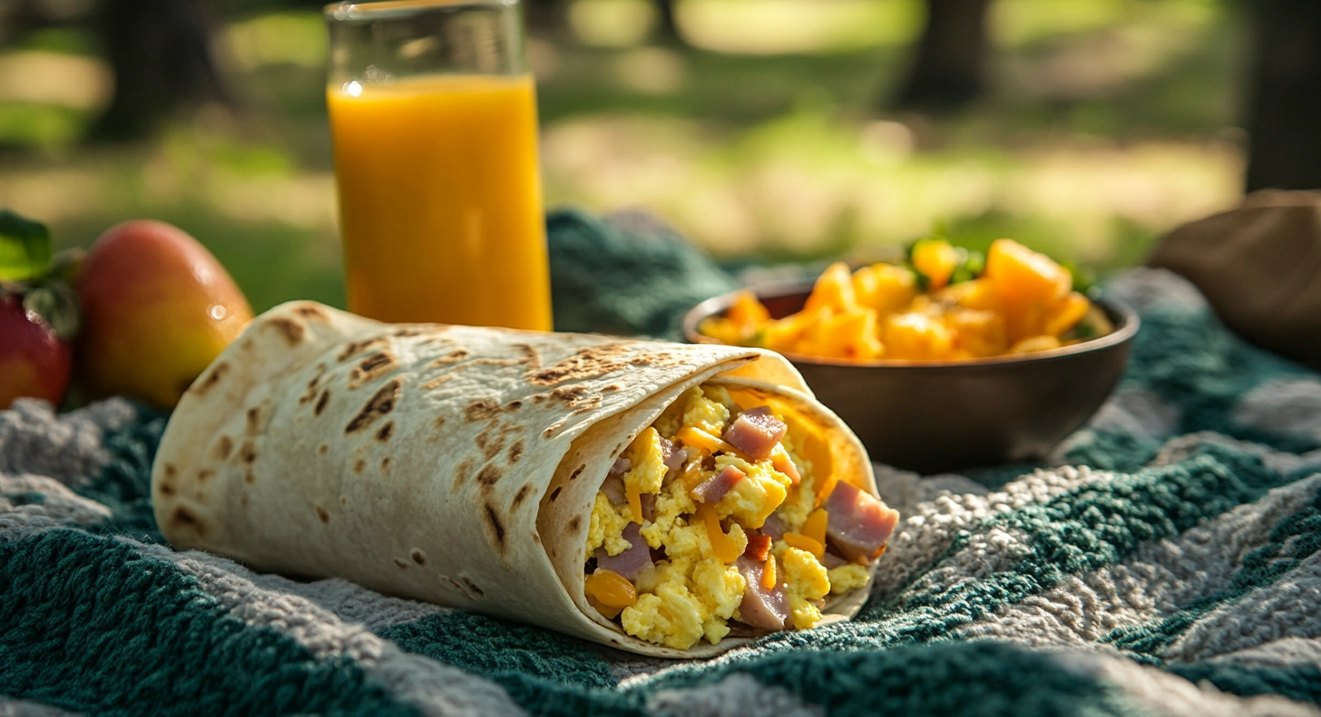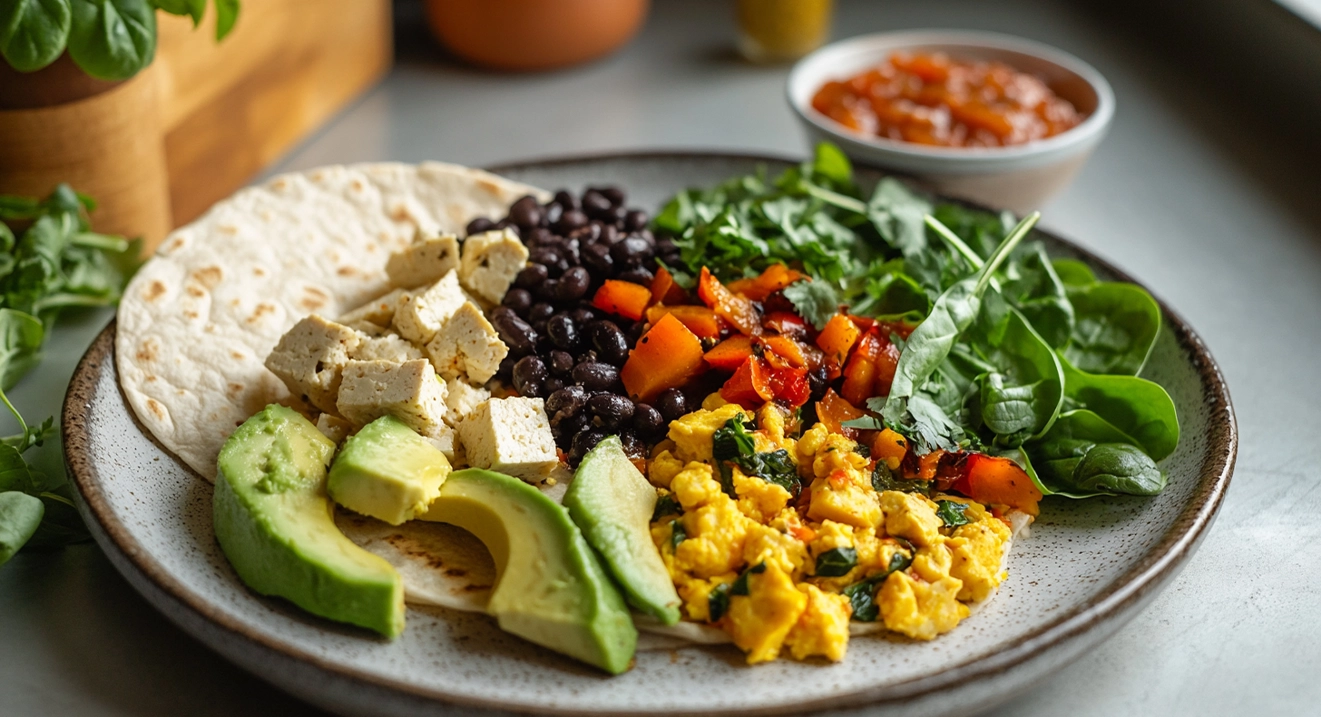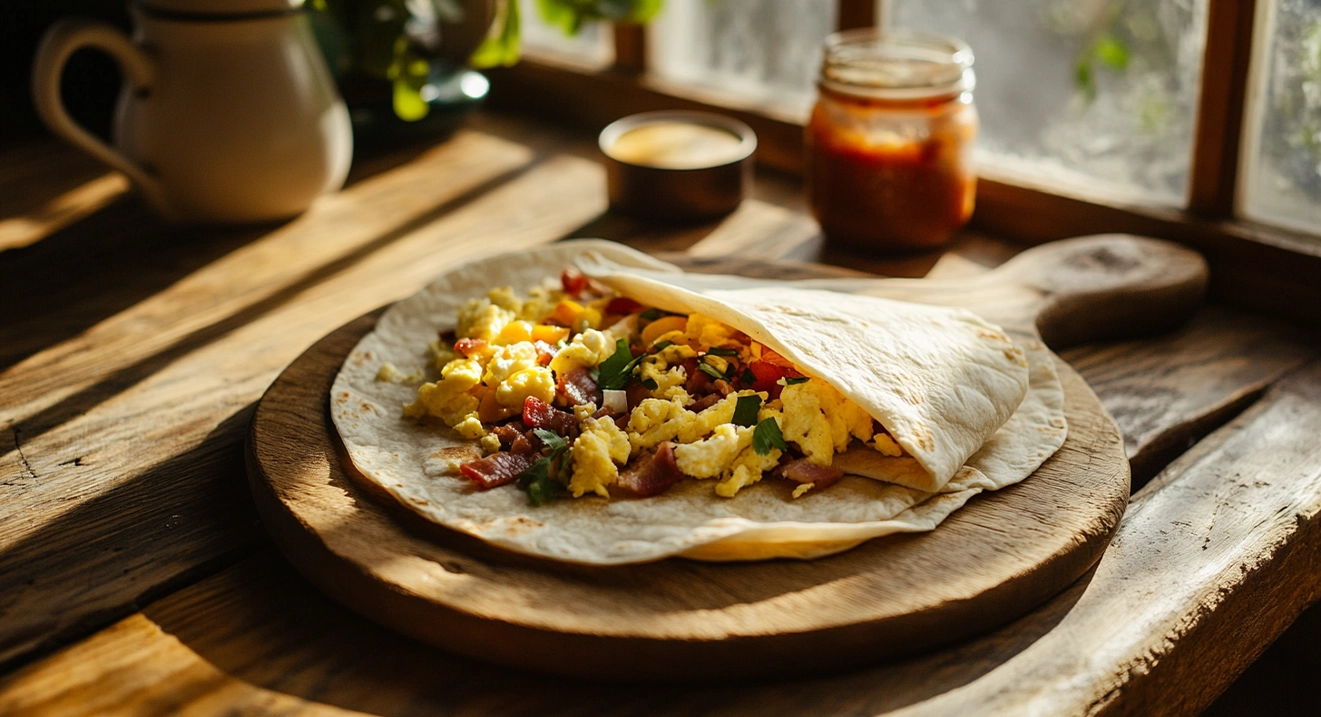Mastering Breakfast Burritos: Tortilla Sizes, Fillings, and Wrapping Tips

Introduction
Breakfast burritos have become a staple in morning routines worldwide, celebrated for their convenience, versatility, and hearty combination of flavors. Whether grabbing one on the go or preparing it at home, this beloved dish blends tradition and innovation. With fillings ranging from eggs, cheese, and vegetables to bacon, sausage, and beans, breakfast burritos cater to a diverse array of tastes and dietary needs.
While many factors contribute to a perfect breakfast burrito—fresh ingredients, well-balanced flavors, and precise preparation—one element often overlooked is the size of the tortilla. The tortilla serves as the foundation, both literally and figuratively, of the breakfast burrito. Choosing the right size influences the structural integrity and affects the overall eating experience. A tortilla that is too small might lead to spillage and an unsatisfying portion. At the same time, one that’s too large can overwhelm the delicate balance of ingredients—understanding why tortilla size matters is key to mastering the art of the breakfast burrito.
Understanding Tortilla Sizes
When making breakfast burritos, the size of the tortilla plays a pivotal role in determining the dish’s structure, convenience, and satisfaction. Tortillas come in various sizes, each designed to suit specific culinary purposes. Understanding these sizes and their uses ensures your breakfast burrito is perfectly balanced and easy to handle.
Standard Tortilla Sizes
Tortillas are available in a range of diameters, typically categorized as small, medium, and large. Small tortillas, measuring 6-8 inches in diameter, are often used for tacos or snack-sized dishes. Medium tortillas, around 8-10 inches in diameter, are versatile and used for quesadillas, wraps, and smaller burritos. Large tortillas, measuring 10-12 inches or more, are most suitable for full-sized burritos and wraps that require extra space for multiple fillings.
Common Measurements for Breakfast Burritos
Large tortillas—usually in the 10-12 inch range—are the preferred breakfast burritos. These larger tortillas provide ample room to include a variety of ingredients such as scrambled eggs, cheese, meats, vegetables, and sauces without risk of tearing or spilling. They also make it easier to fold the burrito securely, ensuring the filling is evenly distributed and intact while eating.
While suitable for lighter, single-filling options, smaller tortillas may not accommodate the diverse and hearty ingredients typically associated with breakfast burritos. Therefore, selecting the right tortilla size is essential to achieving the perfect balance of taste, texture, and portability in your morning meal.
Key Factors in Choosing the Right Size
The tortilla size you choose for your breakfast burrito impacts its overall taste, texture, and practicality. Several factors come into play when selecting the ideal size.
Filling Capacity
One of the most critical considerations is how much filling a tortilla can hold. Larger tortillas, typically 12 inches or more, are ideal for accommodating various ingredients, from eggs and meats to vegetables and sauces. Medium tortillas, around 8-10 inches, are suitable for moderate portions, while small tortillas (6 inches) are best for more straightforward, single-filling options or snack-sized servings.
Portability
Breakfast burritos are often a grab-and-go meal, making portability an essential factor. A well-constructed burrito using a larger tortilla is more straightforward to wrap securely and less likely to fall apart during transport. Smaller tortillas, while portable, may offer a different level of structural integrity, particularly when packed with multiple fillings.
Cooking and Folding Considerations
The ease of cooking and folding varies with tortilla size. Larger tortillas are more straightforward to fold into a burrito shape without tearing, making them a popular choice for breakfast burritos. Smaller tortillas may be quicker to warm up on a grill but can be trickier to fold neatly, especially when overfilled. Medium tortillas strike a balance, offering enough room for fillings while remaining manageable during preparation.
Types of Tortillas Used for Breakfast Burritos

The type of tortilla you choose influences the flavor, texture, and overall experience of your breakfast burrito. Here are the most common options:
Flour Tortillas
Flour tortillas are the most popular choice for breakfast burritos due to their softness, flexibility, and ability to hold a variety of ingredients without breaking. Their neutral flavor complements savory and sweet fillings, making them versatile and practical.
Corn Tortillas
Corn tortillas offer a distinct flavor and are a traditional choice in Mexican cuisine. While they are less commonly used for breakfast burritos, they are perfect for those seeking a more authentic taste. However, they are smaller and less pliable than flour tortillas, making folding and wrapping more challenging.
Other Specialty Options
Specialty tortillas, such as whole wheat, spinach, or gluten-free varieties, cater to specific dietary needs or preferences. These tortillas add unique flavors and textures, making them an appealing alternative for health-conscious or adventurous eaters.
Pros and Cons of Different Tortilla Sizes
Each tortilla size has advantages and drawbacks, depending on the intended use and personal preferences.
Small Tortillas (6 inches)
- Pros: These are perfect for lighter meals, single fillings, or snack-sized portions. They are quick to cook and easy to handle.
- Cons: Limited filling capacity; not ideal for the complex and hearty ingredients typical of breakfast burritos.
Medium Tortillas (8–10 inches)
- Pros: It is versatile and suitable for a wide range of fillings without being overly large. It is also easier to fold and cook than smaller or more extensive options.
- Cons: May only accommodate a few large or elaborate fillings as effectively as larger tortillas.
Large Tortillas (12+ inches)
- Pros: It is ideal for full-sized breakfast burritos with various ingredients. It is also excellent for folding and wrapping securely without tearing.
- The cons are that they can be more challenging for some cooks and may be too large for those seeking smaller portions or lighter meals.
Common Breakfast Burrito Fillings
The beauty of a breakfast burrito lies in its versatility, allowing you to customize it with various ingredients to suit your taste and dietary preferences. Here are some of the most popular fillings that contribute to a delicious and satisfying breakfast burrito:

Proteins
- Eggs: Scrambled eggs form the foundation of most breakfast burritos, offering a creamy texture and rich flavor that pairs well with other ingredients.
- Bacon: Crispy bacon adds a savory crunch and a smoky, salty flavor that complements softer fillings like eggs and cheese.
- Sausage: Ground or sliced sausage provides a hearty, flavorful addition, with options ranging from spicy chorizo to mild breakfast links.
Vegetables
- Peppers: Bell peppers, significantly when sautéed, add a sweet, crunchy element and a vibrant pop of color.
- Onions: Sautéed or caramelized onions enhance the burrito with a savory, slightly sweet depth of flavor.
- Spinach: Fresh or wilted spinach offers a nutritious and mildly earthy note, balancing more decadent ingredients like cheese or meats.
Extras
- Cheese: Melted cheese, such as cheddar, Monterey Jack, or pepper jack, adds creaminess and a tangy richness to the burrito.
- Salsa: Fresh or jarred salsa introduces a burst of flavor with its combination of tomatoes, onions, and spices, offering a mild or spicy kick.
- Sour Cream: A dollop of sour cream provides an incredible, tangy contrast to warm, spicy fillings, enhancing the overall flavor profile.
These ingredients can be mixed and matched to create a breakfast burrito that is as simple or elaborate as you desire. Combining proteins, vegetables, and extras ensures a balanced, flavorful, and satisfying meal to start your day.
Regional Variations in Tortilla Sizes for Breakfast Burritos
The size and style of tortillas used for breakfast burritos vary widely across regions, influenced by local culinary traditions, cultural preferences, and ingredient availability. Here’s a look at how these variations shape the breakfast burrito experience:
US Regional Trends
In the United States, breakfast burritos are a staple in many regions, but the size of the tortilla often reflects local preferences and lifestyles.
- Southwest: Texas, New Mexico, and Arizona are known for large tortillas (12+ inches) that accommodate generous fillings, often inspired by Tex-Mex flavors such as scrambled eggs, chorizo, and green chile.
- West Coast: California’s breakfast burritos often feature oversized tortillas to hold a variety of ingredients like avocado, salsa, and hash browns, reflecting the state’s emphasis on bold flavors and fresh produce.
- East Coast and Midwest: Smaller to medium-sized tortillas (8–10 inches) are more common in these regions. They are often used for simpler, more portable breakfast burritos suitable for busy, on-the-go lifestyles.
Mexican Influence
Tortilla sizes and styles vary by region and purpose in Mexico, where the burrito originated. Although breakfast burritos are not a traditional Mexican dish, they draw heavily from Mexican culinary traditions.
- Corn Tortillas: Smaller, hand-made corn tortillas (6–8 inches) are a staple in many regions of Mexico, but these are typically used for tacos rather than burritos.
- Northern Mexico: In northern states like Chihuahua and Sonora, flour tortillas are larger (up to 12 inches) and more common, reflecting the influence of wheat cultivation in the region. These tortillas have directly inspired the development of breakfast burritos in the United States.
Global Breakfast Burrito Trends
As breakfast burritos gain popularity worldwide, tortilla sizes and styles continue to adapt to local tastes and preferences.
- Europe: Smaller, lighter tortillas are often used, and fillings include local ingredients such as ham, cheese, and sautéed vegetables, creating a European twist on the classic breakfast burrito.
- Asia: In some countries, breakfast burritos are reimagined with Asian flavors, incorporating ingredients like rice, kimchi, or curry. Tortilla sizes vary but tend to lean toward medium for manageable portions.
- Australia and New Zealand: Large tortillas are commonly used, often filled with a mix of traditional breakfast staples like eggs and bacon alongside local ingredients such as beetroot or avocado.
How to Make the Perfect Breakfast Burrito

Breakfast burritos are the ultimate grab-and-go meal, combining convenience, versatility, and flavor. Whether you’re aiming for a hearty Tex-Mex experience or a lighter, veggie-packed wrap, choosing the right tortilla and mastering the art of assembly are crucial.
Tortilla Selection
Selecting the right tortilla is the foundation of a great burrito. For larger, hearty meals, go for a 12-inch tortilla, ideal for holding multiple fillings. If you prefer a smaller portion, an 8-inch tortilla can work, though it limits the filling options.
For tips on pairing tortillas with flavorful dishes, check out our burrito recipe, which highlights different filling and wrapping techniques.
Filling Suggestions
A good breakfast burrito includes a mix of proteins, veggies, and extras:
- Proteins: Eggs, bacon, or sausage are classics.
- Veggies: Add spinach, onions, and peppers for color and nutrition.
- Extras: Cheese, salsa, and sour cream enhance flavor and texture.
If you want similar comfort food ideas, explore this chicken casserole recipe for inspiration.
Wrapping Techniques
- Warm the Tortilla: This prevents breakage.
- Layer the Fillings: Keep them in the center.
- Fold and Roll: Tuck the sides, fold the bottom, and roll tightly.
For more wrapping tips, see our guide on chicken quesadillas, which offers a step-by-step folding technique.
Regional Burrito Styles
Did you know burritos vary by region? Dive into the Southwest’s Tex-Mex approach or explore traditional Mexican styles with smaller tortillas. For more regional twists, check out these chicken tacos for a vibrant alternative.
FAQs
What size tortilla is best for burritos?
The ideal size for a burrito tortilla is typically 10–12 inches in diameter. This size provides enough surface area to accommodate a generous filling while allowing for easy folding and wrapping without tearing.
Can you make burritos with 8-inch tortillas?
You can make burritos with 8-inch tortillas, but they will be smaller and hold less filling than traditional burritos. These are sometimes called “mini burritos, “perfect for lighter meals or kids. However, larger tortillas are recommended for a classic, full-sized burrito experience.
What type of tortilla do you use for burritos?
Flour tortillas are the most commonly used for burritos due to their flexibility and strength, which help hold multiple ingredients without breaking. While corn tortillas are traditional in Mexican cuisine, they are less pliable and more suited for tacos than burritos. Specialty options like whole wheat, spinach, or gluten-free tortillas can also be used based on dietary preferences.
How do you wrap a 12-inch burrito?
- Warm the Tortilla: Heat the 12-inch tortilla on a skillet for a few seconds on each side to make it pliable.
- Add Fillings: Place your fillings in the center of the tortilla, leaving space (about 2–3 inches) around the edges.
- Fold the Sides: Fold the left and right sides inward, partially covering the filling.
- Fold the Bottom: Bring the bottom edge up and over the filling, tucking it in tightly.
- Roll It Up: Roll the burrito tightly toward the top edge, keeping the sides tucked in.
- Seal the Burrito: Place the burrito seam-side down on a hot skillet for a few seconds to seal and secure the fold.
Conclusion
The breakfast burrito is a versatile and satisfying meal that has become a staple in morning routines worldwide. From choosing the right tortilla size to mastering the art of folding and wrapping, every element creates the perfect breakfast burrito experience. Understanding the variety of tortilla options, common fillings, and regional influences allows you to customize your burrito to suit your tastes and needs.
Whether you prefer a hearty, full-sized burrito with a 12-inch tortilla or a lighter option with an 8-inch wrap, the key is to balance the flavors and ensure the structure is secure. For those who want to take it a step further, making homemade tortillas adds a personal touch that elevates the dish even more.
Ultimately, the breakfast burrito is not just a meal—it’s a canvas for creativity and culinary exploration, adaptable to any palate or lifestyle. You can enjoy this beloved dish anytime, anywhere, with the right tools, techniques, and ingredients.
